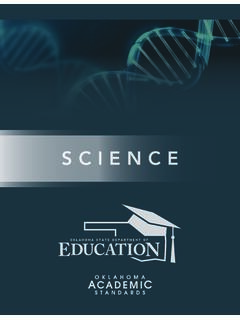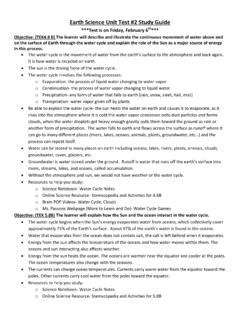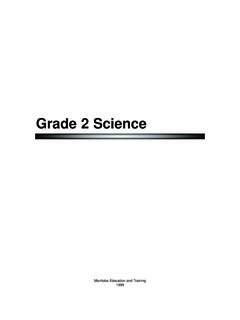Transcription of Item Specifications - Science - Grade 2
1 Grade 2 Science Item Specifications Table of Contents ..3 Physical ..6 ..6 ..10 ..12 Life Earth and Space ..18 Engineering, Technology, and Application of Introduction In 2014 Missouri legislators passed House Bill 1490, mandating the development of the Missouri Learning Expectations. In April of 2016, these Missouri Learning Expectations were adopted by the State Board of Education. Groups of Missouri educators from across the state collaborated to create the documents necessary to support the implementation of these expectations.
2 One of the documents developed is the item specification document, which includes all Missouri Grade level/course expectations arranged by domains/strands. It defines what could be measured on a variety of assessments. The document serves as the foundation of the assessment development process. Although teachers may use this document to provide clarity to the expectations, these Specifications are intended for summative, benchmark, and large-scale assessment purposes. Components of the item Specifications include: Expectation Unwrapped breaks down a list of clearly delineated content and skills the students are expected to know and be able to do upon mastery of the Expectation.
3 Depth of Knowledge (DOK) Ceiling indicates the highest level of cognitive complexity that would typically be assessed on a large scale assessment. The DOK ceiling is not intended to limit the complexity one might reach in classroom instruction. Item Format indicates the types of test questions used in large scale assessment. For each expectation, the item format specifies the type best suited for that particular expectation. Content Limits/Assessment Boundaries are parameters that item writers should consider when developing a large scale assessment. For example, some expectations should not be assessed on a large scale assessment but are better suited for local assessment.
4 Page 3 of 30 Sample stems are examples that address the specific elements of each expectation and address varying DOK levels. The sample stems provided in this document are in no way intended to limit the depth and breadth of possible item stems. The expectation should be assessed in a variety of ways. Possible Evidence indicates observable methods in which a student can show understanding of the expectations. Stimulus Materials defines types of stimulus materials that can be used in the item stems. Page 4 of 30 Grade 2 Science Physical sciences Core Idea Component MLS Matter and Its Interactions Structure and Properties of Matter Plan and conduct an investigation to describe and classify different kinds of materials by their observable properties.
5 Expectation Unwrapped [Clarification Statement: Observations could include color, texture, hardness, and flexibility. Patterns could include the similar properties that different materials share.] Science AND ENGINEERING PRACTICES Plan and Conduct an Investigation Plan and conduct an investigation collaboratively to produce data to serve as the basis for evidence to answer a question. DISCIPLINARY CORE IDEAS Structures and Properties of Matter Classify different kinds of materials by their observable properties Different properties are suited to different purposes.
6 Which materials will be observed at different temperature, and how those temperatures will be determined ( , using ice to cool and a lamp to warm) and measured ( , qualitatively or quantitatively). CROSSCUTTING CONCEPTS Patterns To describe and classify Patterns in the natural and human designed world can be observed DOK Ceiling 3 Item Format Selected Response Constructed Response Technology Enhanced Content Limits/Assessment Boundaries Tasks should avoid phase change and molecular-level activity Tasks should avoid molecule arrangement Sample Stems Page 5 of 30 Grade 2 Science Possible Evidence Students develop an investigation to classify different kinds of materials ( , metals, rocks, wood, soil, powders)
7 Students identify how properties of materials will be determined and classified Students collect and record data on the properties of the materials. Draw a picture graph and a bar graph (with single-unit scale) to represent a data set with up to four categories. Solve simple put-together, take-apart, and compare problems using information presented in a bar graph. Stimulus Materials Graphic organizers, diagrams, graphs, data tables, drawings Page 6 of 30 Grade 2 Science Physical sciences Core Idea Component MLS Matter and Its Interactions Structure and Properties of Matter Analyze data obtained from testing different materials to determine which materials have the properties that are best suited for an intended purpose.
8 Expectation Unwrapped [Clarification Statement: Examples of properties could include, strength, flexibility, hardness, texture, and absorbency.] Science AND ENGINEERING PRACTICES Analyzing and Interpreting Data Analyze data from tests of an object or tool to determine if it works as intended. DISCIPLINARY CORE IDEAS Structures and Properties of Matter Different properties are suited to different purposes. CROSSCUTTING CONCEPTS Cause and Effect Simple tests can be designed to gather evidence to support or refute student ideas about causes. ENGINEERING DESIGN Refer to Engineering, Technology, and Application of Science DOK Ceiling 3 Item Format Selected Response Constructed Response Technology Enhanced Content Limits/Assessment Boundaries Assessment of quantitative measurements is limited to length using nonstandard measurement unless standard measurement has been taught.
9 Allow students to contribute to the materials being evaluated and the number of tests being run. Sample Stems Page 7 of 30 Grade 2 Science Possible Evidence Simple tests can be designed to gather evidence to support or refute student ideas about causes. Using graphical displays ( , picture charts, Grade -appropriate graphs); using the given data from tests of different materials to organize those materials by their properties ( , strength, flexibility, hardness, texture, and ability to absorb).
10 Build on prior experiences and progress to collect, record, and share observations. Students use their organized data to support or refute their ideas about which properties of materials make the object or tool best suited for the intended purpose relative to the other given objects/tools. Students describe how the given data from the tests provide evidence of the suitablity of different materials for the intended purpose. Students identify and describe relationships between properties of materials and some potential uses for the intended purpose ( , roughness is good for keeping objects in place; flexibility is good for keeping materials from breaking, but not good for keeping materials rigidly in place).



















